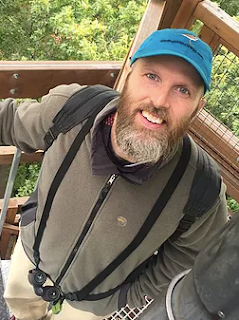I see the introduced European Starling on just about every Bay Area birding outing. The species is so widespread and abundant I think of it as a native species. I count it on my ABA list and my Bay Area bike list - the only two lists I care about. I eBird starling without hesitation.
In contrast, I see the introduced Red-masked Parakeet on some of my San Francisco birding outings. I know the species is introduced and treat it differently than native species. It is not on any of my lists, and I don't even bother to eBird it since I don't want it 'contaminating' my species totals (and yes, I realize I'm selectively skewing the data by doing that. But who cares, its Red-Masked Parakeet).
The introduced European Starling
Both the starling and the parakeet are introduced, so why do I consciously draw a distinction between them for listing purposes? It is because the starling is so comparatively widespread? Is it because the ABA deems the starling a countable species? It is because there is some unspoken agreement among birders letting us treat the starling one way and the parakeet another?
I don't know the answers to these questions, but I do know some ultra-pure listers ignore all introduced species, presumably to avoid drawing the sorts of arbitrary designations I've highlighted above. Those strictest listers will often quote their various lists with the caveat 'NIB' - non-introduced birds - attached. Though I don't adhere to this convention, I understand it and think it makes general sense.
The introduced Rock Dove
Or does it? All of the introduced species I've mentioned in this article are infinitely more a part of the North American avifauna than, say, the continuing Red-flanked Bluetail in Los Angeles. From an ecological or demographic standpoint, the Bluetail is irrelevant; it's nothing more than a statistical anomaly. If we're so concerned about birds that are naturally North American, then the Bluetail should be the last bird on our collective mind, right?
On a boat....
(Thanks to Paul Reinstein for the Bluetail photo!)
I present these musings mostly to elicit opinions/comments from those of you who haven't fallen asleep by this point. I'm as certain as anyone the Bluetail is a natural vagrant, but I think our treatment of 'natural' might need to shift moving forward. The same for introduced birds that outstrip native species. Birds like Whooping Crane and California Condor present other sorts of intrigue; humans rescued those species from human-created population crashes. Should that mean anything for countability? Listing is fun but the whole process can feel like a black box. I particularly feel for folks on records committees; trying to sort out what should count and what shouldn't seems like trying to run the 100-yard dash in a 90-yard gym. Photography sometimes seems so much simpler. Here's a native bird to close, later.....
Dunlin - Calidris alpina
San Mateo County, California
Canon 600mm f/4 IS II on EOS 1DX Mark II
1/5000 at f/4, ISO 400, handheld














